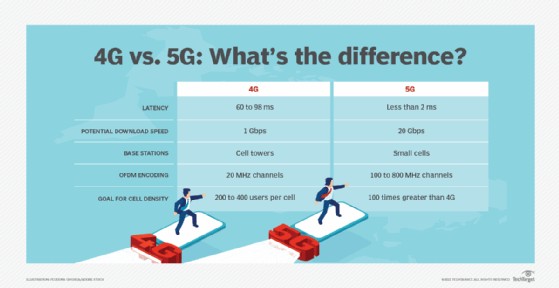5G is the latest generation of cellular network technology, promising significantly faster speeds than its predecessor, 4G. But just how much faster is 5G? This article delves into the key differences between 4G and 5G, focusing on speed, latency, and the technologies that enable these improvements.
 Table that compares 4G and 5G A comparison table highlighting the key differences between 4G and 5G.
Table that compares 4G and 5G A comparison table highlighting the key differences between 4G and 5G.
Understanding the Speed Gap: 4G vs. 5G
While 4G offered a significant leap forward in mobile internet speeds, reaching up to 100 Mbps, 5G aims to revolutionize connectivity with speeds up to 100 times faster. In ideal conditions, using millimeter wave (mmWave) technology, 5G can achieve peak download speeds between 10 Gbps and 20 Gbps. However, typical real-world speeds are closer to 1 Gbps to 3 Gbps, still a considerable improvement over 4G’s typical 20 Mbps to 100 Mbps.
Beyond Speed: Latency and Other Key Differences
The speed difference isn’t the only factor that sets 5G apart. Latency, the delay before a transfer of data begins following an instruction for its transfer, is significantly lower in 5G. 5G boasts latency under 5 milliseconds, crucial for real-time applications, compared to 4G’s 20 to 40 milliseconds. This improvement enables faster response times and greater network efficiency.
Other key distinctions include:
Base Stations:
4G relies on traditional cell towers for signal transmission. 5G, leveraging mmWave’s higher frequencies and shorter range, utilizes smaller, more densely deployed “small cells” roughly the size of pizza boxes. This allows for greater capacity and coverage in densely populated areas. 5G also utilizes existing cell towers for lower frequency bands.
OFDM Encoding:
Both 4G and 5G employ Orthogonal Frequency-Division Multiplexing (OFDM), a method of splitting wireless signals into multiple channels to avoid interference. However, 5G utilizes wider channels (100 MHz to 800 MHz with mmWave) compared to 4G (1.4 MHz to 20 MHz), enabling higher data throughput and faster speeds.
Cell Density:
The deployment of small cells significantly increases 5G’s cell density, allowing networks to support a much larger number of connected devices and users compared to 4G. This addresses one of 4G’s shortcomings, paving the way for the growing Internet of Things (IoT) and increased mobile device usage.
The Transition from 4G to 5G
While 4G remains widely used, the transition to 5G is underway. 5G offers significant advantages in speed, latency, reliability, and security, making it ideal for industries requiring real-time communication and high bandwidth, such as healthcare, manufacturing, and autonomous vehicles. The availability of 5G depends on location and carrier support, with standalone (SA) 5G infrastructure offering the full potential of the technology compared to non-standalone (NSA) 5G, which relies on existing 4G infrastructure.
Conclusion
5G is substantially faster than 4G, offering speeds up to 100 times faster in ideal conditions and significantly lower latency. Beyond speed, improvements in base station technology, encoding methods, and cell density contribute to 5G’s superior performance and capacity. While the transition is ongoing, 5G represents a significant leap forward in mobile connectivity, enabling a new era of applications and possibilities.

